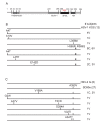The herpevac trial for women: Sequence analysis of glycoproteins from viruses obtained from infected subjects
- PMID: 28448558
- PMCID: PMC5407825
- DOI: 10.1371/journal.pone.0176687
The herpevac trial for women: Sequence analysis of glycoproteins from viruses obtained from infected subjects
Abstract
The Herpevac Trial for Women revealed that three dose HSV-2 gD vaccine was 58% protective against culture-positive HSV-1 genital disease, but it was not protective against HSV-2 infection or disease. To determine whether vaccine-induced immune responses had selected for a particular gD sequence in strains infecting vaccine recipients compared with viruses infecting control subjects, genetic sequencing studies were carried out on viruses isolated from subjects infected with HSV-1 or HSV-2. We identified naturally occurring variants among the gD sequences obtained from 83 infected subjects. Unique or low frequency amino acid substitutions in the ectodomain of gD were found in 6 of 39 HSV-1-infected subjects and in 7 of 44 HSV-2-infected subjects. However, no consistent amino acid change was identified in isolates from gD-2 vaccine recipients compared with infected placebo recipients. gC and gE surround and partially shield gD from neutralizing antibody, and gB also participates closely in the viral entry process. Therefore, these genes were sequenced from a number of isolates to assess whether sequence variation may alter protein conformation and influence the virus strain's capacity to be neutralized by vaccine-induced antibody. gC and gE genes sequenced from HSV-1-infected subjects showed more variability than their HSV-2 counterparts. The gB sequences of HSV-1 oral isolates resembled each other more than they did gB sequences rom genital isolates. Overall, however, comparison of glycoprotein sequences of viral isolates obtained from infected subjects did not reveal any singular selective pressure on the viral cell attachment protein or surrounding glycoproteins due to administration of gD-2 vaccine.
Conflict of interest statement
Figures





Similar articles
-
Molecular analyses and phylogeny of the herpes simplex virus 2 US9 and glycoproteins gE/gI obtained from infected subjects during the Herpevac Trial for Women.PLoS One. 2019 Mar 8;14(3):e0212877. doi: 10.1371/journal.pone.0212877. eCollection 2019. PLoS One. 2019. PMID: 30849089 Free PMC article.
-
Patient-Specific Neutralizing Antibody Responses to Herpes Simplex Virus Are Attributed to Epitopes on gD, gB, or Both and Can Be Type Specific.J Virol. 2015 Sep;89(18):9213-31. doi: 10.1128/JVI.01213-15. Epub 2015 Jun 24. J Virol. 2015. PMID: 26109729 Free PMC article.
-
Efficacy of the Herpes Simplex Virus 2 (HSV-2) Glycoprotein D/AS04 Vaccine against Genital HSV-2 and HSV-1 Infection and Disease in the Cotton Rat Sigmodon hispidus Model.J Virol. 2015 Oct;89(19):9825-40. doi: 10.1128/JVI.01387-15. Epub 2015 Jul 15. J Virol. 2015. PMID: 26178984 Free PMC article.
-
Characterization of B virus glycoprotein antibodies induced by DNA immunization.Arch Virol. 2002 Nov;147(11):2057-73. doi: 10.1007/s00705-002-0889-0. Arch Virol. 2002. PMID: 12417944
-
Comparison of different forms of herpes simplex replication-defective mutant viruses as vaccines in a mouse model of HSV-2 genital infection.Virology. 2001 Sep 30;288(2):256-63. doi: 10.1006/viro.2001.1094. Virology. 2001. PMID: 11601897
Cited by
-
Multiple Class I and Class II Haemophilus ducreyi Strains Cause Cutaneous Ulcers in Children on an Endemic Island.Clin Infect Dis. 2018 Nov 13;67(11):1768-1774. doi: 10.1093/cid/ciy343. Clin Infect Dis. 2018. PMID: 29897409 Free PMC article.
-
Neutralizing Antibody Kinetics and Immune Protection Against Herpes Simplex Virus 1 Genital Disease in Vaccinated Women.J Infect Dis. 2023 Feb 14;227(4):522-527. doi: 10.1093/infdis/jiac067. J Infect Dis. 2023. PMID: 35199165 Free PMC article. Clinical Trial.
-
Molecular analyses and phylogeny of the herpes simplex virus 2 US9 and glycoproteins gE/gI obtained from infected subjects during the Herpevac Trial for Women.PLoS One. 2019 Mar 8;14(3):e0212877. doi: 10.1371/journal.pone.0212877. eCollection 2019. PLoS One. 2019. PMID: 30849089 Free PMC article.
-
The Importance of Glycans of Viral and Host Proteins in Enveloped Virus Infection.Front Immunol. 2021 Apr 29;12:638573. doi: 10.3389/fimmu.2021.638573. eCollection 2021. Front Immunol. 2021. PMID: 33995356 Free PMC article. Review.
-
Toward the Eradication of Herpes Simplex Virus: Vaccination and Beyond.Viruses. 2024 Sep 17;16(9):1476. doi: 10.3390/v16091476. Viruses. 2024. PMID: 39339952 Free PMC article. Review.
References
-
- Roizman B, D.M. K, Whitley RJ (2013) Herpes Simplex Viruses In: Knipe DM, Howley PM, editors. Fields Virology. 6 ed. FIields Virology: Lippincott Williams & Wilkins; pp. 1823–1897.
-
- Bernstein DI, Bellamy AR, Hook EW 3rd, Levin MJ, Wald A, et al. (2013) Epidemiology, clinical presentation, and antibody response to primary infection with herpes simplex virus type 1 and type 2 in young women. Clin Infect Dis 56: 344–351. doi: 10.1093/cid/cis891 - DOI - PMC - PubMed
-
- Bhattarakosol P, Visaprom S, Sangdara A, Mungmee V (2005) Increase of genital HSV-1 and mixed HSV-1 and HSV-2 infection in Bangkok, Thailand. J Med Assoc Thai 88 Suppl 4: S300–304. - PubMed
-
- Kortekangas-Savolainen O, Vuorinen T (2007) Trends in herpes simplex virus type 1 and 2 infections among patients diagnosed with genital herpes in a Finnish sexually transmitted disease clinic, 1994–2002. Sex Transm Dis 34: 37–40. doi: 10.1097/01.olq.0000222725.81045.62 - DOI - PubMed
MeSH terms
Substances
LinkOut - more resources
Full Text Sources
Other Literature Sources
Miscellaneous

